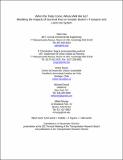When the Tides Come, Where Will We Go?
Author(s)
Rocco, Victor; Dowd, Michael; Murga, Mikel; Han, Yafei; Zegras, Pericles C
DownloadTRB16_17-06839_Final_Submission.pdf (1.035Mb)
OPEN_ACCESS_POLICY
Open Access Policy
Creative Commons Attribution-Noncommercial-Share Alike
Terms of use
Metadata
Show full item recordAbstract
For coastal urban areas, an increase in flooding is one of the clearest climate change threats. The research presented in this paper demonstrates how a land use-transport model can be used to forecast the short-and longer-Term impacts of a potential 4-ft sea level rise in greater Boston, Massachusetts, by 2030. The short-Term scenario represents the immediate transport system response to inundation, which provides a measure of resiliency in the case of an extreme event, such as a storm surge. In the short run, the results reveal that transit captive users will suffer more. Transit, in general, displays less resiliency, at least in part because of the center city's vulnerability and Boston's radial transit system. Trip distances would modestly decrease, and average travel speeds would go down by more than 50%. Rail transit ridership would be decimated, and overall transit usage would go down by 66%. The longer-Term scenario predicts how households and firms would prefer to relocate in the so-called new equilibrium when more than 10 mi2 of land disappears and the transport network inundations become permanent. Assuming no supply constraints, new residential growth centers would emerge on the peripheries of the inundated zones, primarily in the inner-core suburbs. Some regional urban centers and traditional industrial towns would boom. Firms would be hit harder, because of their heavy concentration in the inner core; firm relocation would largely follow households. Transit usage would again be decimated, but walking trips would increase. Results, however, should be viewed as cautious speculation.
Date issued
2017Department
Massachusetts Institute of Technology. Department of Civil and Environmental Engineering; Massachusetts Institute of Technology. Department of Urban Studies and PlanningJournal
Transportation Research Record: Journal of the Transportation Research Board
Publisher
Transportation Research Board
Citation
Han, Yafei, et al. “When the Tides Come, Where Will We Go?” Transportation Research Record: Journal of the Transportation Research Board 2653 (January 2017): 54–64
Version: Author's final manuscript
ISSN
0361-1981